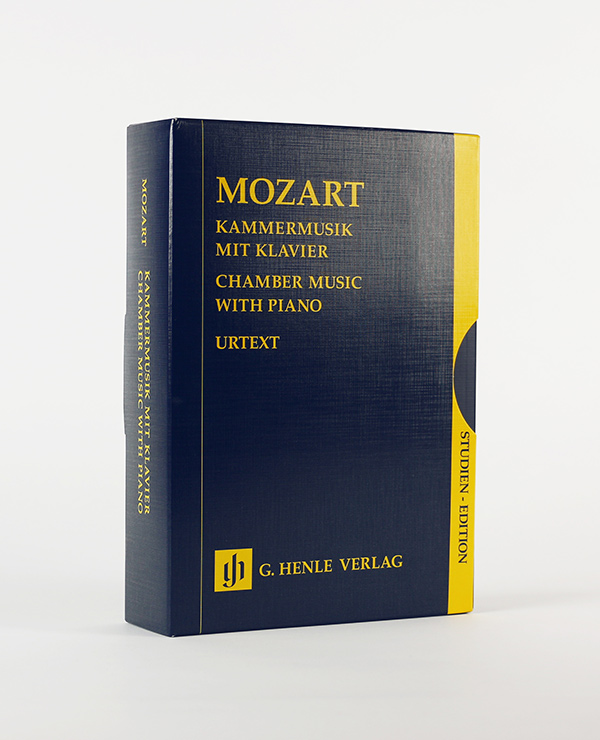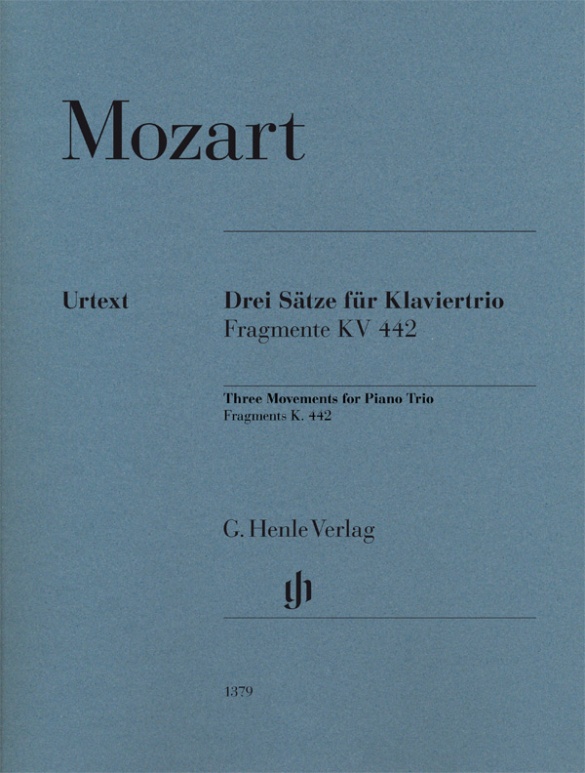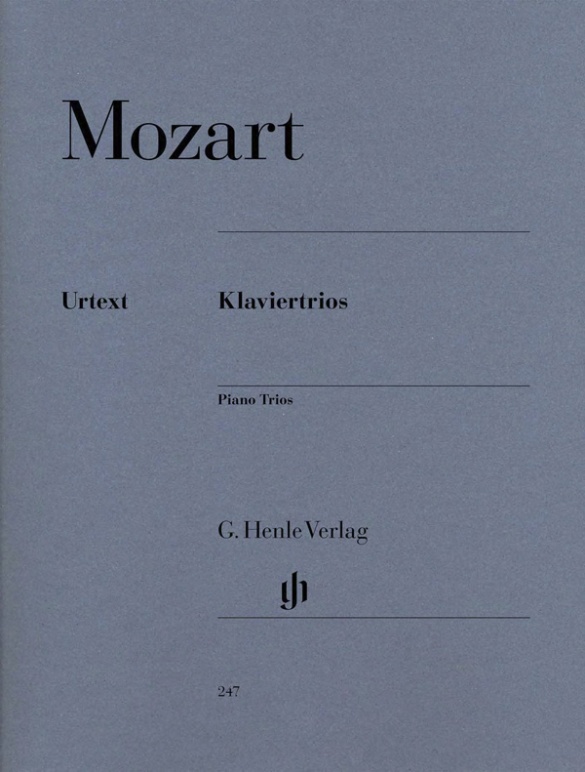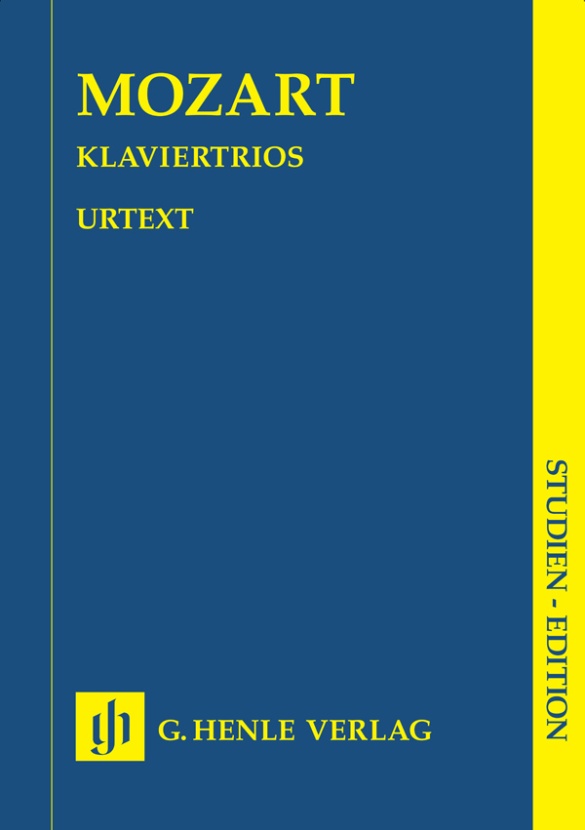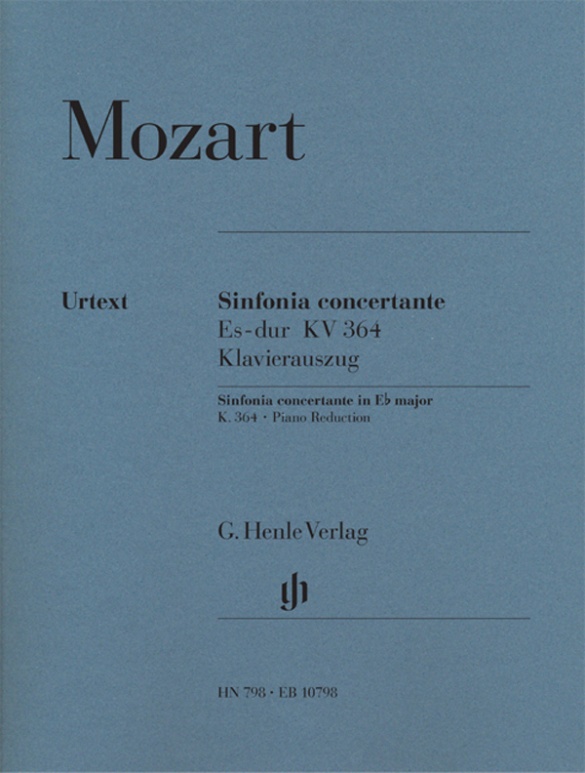Wolfgang Amadeus Mozart
Musique de chambre avec piano - 4 volumes réunis dans un coffret
Excepté le Quintette K. 452, toutes les éditions Urtext antérieures des titres rassemblés dans cette collection sont présentées pour la première fois dans la version Studien-Edition. Outre les sonates, ce volume «Œuvres pour piano et violon», de plus de 400 pages, inclue aussi les variations. Les «Trios avec piano» ont été spécialement soumis par l’éditeur des parties à une révision approfondie pour l’occasion.
CONTENU/DÉTAILS
CONCERNANT LE COMPOSITEUR

Wolfgang Amadeus Mozart
Mozart est l’un des rares compositeurs à avoir produit des œuvres exemplaires dans tous les genres musicaux. Grâce à ses tournées de concerts entreprises de bonne heure il a recueilli de multiples et diverses impressions musicales (Londres, Mannheim, l’Italie, Paris) qu’il a assimilées au cours de sa jeunesse et qui ont contribué à forger son langage musical jusqu’à son accomplissement.
| 1756 | Né le 27 janvier à Salzbourg, fils du musicien Leopold Mozart, plus tard compositeur de la cour. Un enseignement très précoce de la musique, sous la férule de son père, à partir de 1761 et premières compositions à l’âge de 5 ans. |
| 1763–66 | Assez longues tournées de concerts dans diverses villes allemandes et à Paris, Londres, Amsterdam, en Suisse. Il compose ses premières sonates pour violon et piano K. 10-15, dédiées à la reine Charlotte, de même que les premières symphonies K. 16, 19, écrites à Londres, qui traduisent l’influence des œuvres de Johann Christian Bach et Karl Friedrich Abel (forme tripartite de la Sinfonia italienne). |
| 1767 | Création à Salzbourg du Singspiel sacré «Die Schuldigkeit des ersten Gebotes» («Le devoir du Premier commandement») K. 35 (composé avec Michael Haydn et Anton C. Adlgasser) et de l’Intermède «Apollon et Hyacinthe» K. 38. Voyage avec son père et sa sœur à Vienne. |
| 1768 | Création (peut-être) à Vienne, du Singspiel «Bastien et Bastienne» K. 50. Composition de ses premières messes. |
| 1769 | Représentation du dramma giocoso «La finta semplice» K. 51 à Salzbourg. |
| 1769–71 | Deux voyages en Italie; il rencontre entre autres Farinelli, P. Nardini et le père Martini; rencontre avec Hasse lors du second voyage. Création à Milan en 1770 et 1771 de l’opera seria «Mitridate, Re di Ponto» et de la festa teatrale «Ascanio in Alba». Composition de symphonies et du 1er Quatuor à cordes (1770, K. 80). |
| 1771 | Composition de l’oratorio «La Betulia liberata» K. 118 à Salzbourg et en Italie. |
| 1772 | Création de la Serenata drammatica «Il sogno di Scipione» K. 126 pour l’intronisation de l’archevêque de Salzbourg Hieronymus comte Colloredo. Mozart est engagé et appointé comme Konzertmeister de la chapelle de la cour de Salzbourg (dont il était membre gracieux depuis 1769). Troisième voyage en Italie avec son père, création à Milan du Dramma per musica «Lucio Silla» avec un bon succès. Le dernier voyage en Italie marque la fin de sa jeune phase d’appropriation: il s’est exercé dans tous les genres instrumentaux importants (symphonie, sonate, quatuor à cordes) et dans tous les genres courants de l’opéra (Singspiel, opera buffa, opera seria, festa teatrale). |
| à partir de 1773 | Composition de quatuors à cordes (K. 168-173) sous l’influence de Haydn, de symphonies, divertimenti, sérénades. Sollicité par ses tâches de service, il se consacre plus intensément à la musique sacrée; plusieurs messes voient le jour. Il se lance dans la composition de concertos pour violon et pour piano. |
| 1775 | Création à Munich du dramma giocoso «La finta giardiniera» et de la Sérénade «Il Rè pastore». Sonates pour piano K. 279-284. |
| 1777 | Il quitte provisoirement son poste et entreprend, pour se faire connaître, un voyage avec sa mère à Munich, Mannheim et Paris. |
| 1778 | Composition de la Symphonie parisienne en Ré majeur (K. 297). Il assiste à Paris à la querelle entre Gluckistes et Piccinnistes. Édition de sonates pour violon. |
| 1779 | Il reprend son service à Salzbourg en tant qu’organiste de la cour. Messe du Couronnement en Ut majeur. |
| 1781 | Création à Munich de la tragédie lyrique «Idoménée» qui réalise une symbiose entre des éléments français et italiens. Voyage à Vienne. Après sa rupture avec l’archevêque de Salzbourg, il démissionne et déménage à Vienne où il gagne sa vie en tant que compositeur indépendant et par une activité de concerts et d’enseignement. Sa dernière grande période créatrice vient de commencer. |
| 1782 | Il apprend auprès du baron van Swieten à connaître les œuvres de Bach et de Händel; sur ce il arrange les fugues de Bach et introduit dans ses œuvres le «style savant» (fugue et contrepoint) aux côtés du «style galant» (entre autres les Quatuors à cordes en Sol majeur K. 387, en 1782; la Sonate pour piano en Fa majeur K. 533, en 1786; la Symphonie Jupiter K. 551, en 1788; La «Flûte enchantée» et le Requiem en ré mineur K. 626, les deux en 1791). Création à Vienne du Singspiel «L’Enlèvement au sérail». Composition de la Symphonie Haffner en Ré majeur K. 385. |
| 1738 | Messe en Ut mineur K. 427, Symphonie «Linz» en Ut majeur K. 425. |
| 1784 | Quatuor «La Chasse» en Si bémol majeur K. 458. |
| 1785 | Création de l’oratorio «Davide penitente» K. 469 à Vienne. Quatuor en Ut majeur K. 465 («Les dissonances»). |
| 1786 | Création de la comédie avec musique «Der Schauspieldirektor» (Le Directeur de théâtre) K. 486 dont Salieri triomphe avec son œuvre concurrente «Prima la musica e poi le parole». Création à Vienne de l’opera buffa «Les Noces de Figaro» dont les sections finales à l’action interminable constituent l’apogée de l’opéra bouffe. Symphonie «Prague» en Ré majeur K. 504. |
| 1787 | Sérénade en Sol majeur K. 525 (Une Petite musique de nuit). Il est nommé compositeur de chambre impérial et royal. Création à Prague du dramma giocoso «Il dissoluto punito ossia Il Don Giovanni» (Don Juan) dans lequel fusionnent l’opéra sérieux et l’opéra comique. |
| 1788 | Composition des grandes symphonies en Mi bémol majeur K. 543, en Sol mineur K. 550 et en Ut majeur (Jupiter) K. 551. Quintette pour clarinette en La majeur K. 581. |
| 1790 | Création à Vienne du dramma giocoso «Così fan tutte ossia La scuola degli amanti». |
| 1791 | Création à Prague de l’opera seria «La Clémence de Titus» et à Vienne du Singspiel «La Flûte enchantée». Concerto pour clarinette en La majeur K. 622. Le Requiem demeure inachevé. Il meurt le 5 décembre à Vienne. |
About the Authors
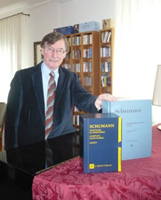
Ernst Herttrich (Editeur)
Dr. Ernst Herttrich, born in 1942 in Würzburg, read musicology, history, German and theology at the universities in Würzburg and Cologne. In 1970 he earned his doctorate in Würzburg with a study of the expression of melancholy in the music of Mozart.
From 1970 to 1990 he was an editor at G. Henle Publishers in Munich, after which he was Head of the Beethoven Complete Edition for over 15 years. In 1999 he took over as Head of the Beethoven-Haus Publishers, and from 2001 was made Head of the Beethoven-Archiv, the research centre at the Beethoven-Haus.
He has been a visiting professor at Meiji Gakuin University in Tokyo and has undertaken several lecture tours both there and to Kyoto. His research interests include source studies, editorial techniques and music history. Herttrich’s publications include “Beethoven. Liederkreis an die ferne Geliebte” (Bonn 1999) and “Ludwig van Beethoven. Biographie in Bildern” (Bonn, 2000). Herttrich has edited over 100 Urtext editions for G. Henle Publishers.
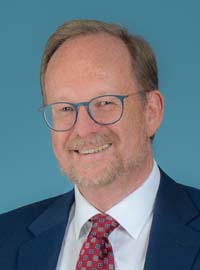
Wolf-Dieter Seiffert (Editeur)
Dr. Wolf-Dieter Seiffert, born in 1959 in Frankfurt/M., read musicology, modern German literature, and philosophy at the Ludwig-Maximilians-Universität in Munich. On a scholarship from the “Studienstiftung des Deutschen Volkes”, he did his doctorate in 1990 with a thesis on “Mozarts frühe Streichquartette” (Rudolf Bockholdt). That same year, Seiffert started work at G. Henle Publishers as an editor. Parallel to his work at the publisher, he completed a diploma in business studies at the St. Gallen University, KMU-HSG, financed by the Günter Henle Foundation. Seiffert was managing director of G. Henle Verlag from 2000 to 2023.
Seiffert has edited numerous Urtext editions for G. Henle Publishers, predominantly on Mozart’s works.
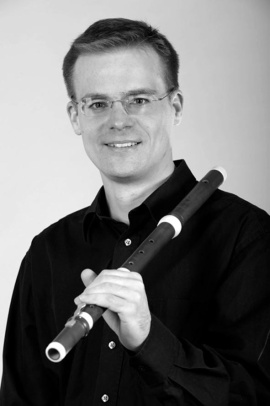
Henrik Wiese (Editeur)
Henrik Wiese was born in 1971 in Vienna. He first studied the flute with Paul Meisen (Munich). He later took a degree in Indo-European studies, general linguistics and musicology. From 1995 to 2006 he was solo flautist at the Bavarian State Opera (Munich), since 2006 he has held the same position with the Bavarian Radio Symphony Orchestra. Wiese was a prize-winner at the German Music Competition (1995) and at several international flute competitions (including the ARD Music Competition in 2000).
As part of his editorial work for G. Henle Publishers, studying sources led him to historical performance practice and the transverse flute. He plays this instrument with the Accademia giocosa. Wiese gives master-classes around the world and tries to impart an understanding of how to deal with editions and sources to his pupils, to show them how to write cadenzas and to hone their awareness of intonation. His artistic work as a soloist, chamber musician and orchestral musician has been documented on numerous CDs.
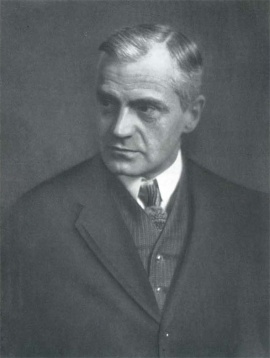
Walther Lampe (Doigtés)
Prof. Walther Lampe, born in 1872 in Leipzig, died in 1964 in Munich, studied the piano with Clara Schumann at the Hoch’schen Konservatorium in Frankfurt, as well as music theory and composition. He concluded his studies in Berlin, where he was a student of Herzogenberg and Humperdinck.
He first appeared as a concert pianist, but in 1920 was appointed as a professor and head of a class at the Münchener Akademie der Tonkunst. After Lampe was given emeritus status in 1937, he took on a piano class at the Mozarteum in Salzburg. Günter Henle, who grew up in Munich, was a private pupil of Lampe’s, from the age of 15 (in 1914). In his autobiography he wrote of his piano teacher in the following glowing terms:
“The years in which Walther Lampe, the renowned pianist and Head of piano master-classes in Munich and Salzburg, instructed me in the higher mysteries of piano playing, are amongst the most treasured memories of my youth. […] Lampe, himself an excellent concert pianist, had the reputation of being one of the leading teachers. Due to his practical experience of many decades he was able to pass on his great knowledge and skill both in words and through his own playing in a highly inspiring and supportive manner. His interpretations of Mozart were positively divine. […] I remain indebted to him for his great artistic suggestions and his friendship, which he shared with me over decades.”
During the first few years of World War II, Günter Henle looked up his old teacher and friend in Munich several times to play music with him. It was self-evident for Günter Henle to inform Walther Lampe of his plans to set up his music publishing house shortly after the end of the war, asking him for his help and advice. Lampe was very actively involved in the first editions: almost all of the Urtext editions published in the early years were supervised intensively by Lampe, a fact which is attested by the comprehensive correspondence in the archives of G. Henle Publishers. And Lampe also contributed his own fingerings to almost all of these editions. It is a very impressive list of titles, which even today still form part of G. Henle Publishers’ core repertoire.

Klaus Schilde (Doigtés)
Prof. Klaus Schilde, born in 1926, spent his childhood in Dresden. There he was greatly influenced by Walter Engel, who taught him the piano (Kodaly method), composition and violin. From 1946–1948 he studied at the music conservatory in Leipzig with Hugo Steurer. After moving to the west in 1952 he studied with Walter Gieseking and Edwin Fischer, as well as with Marguerite Long, Lucette Descaves and Nadia Boulanger in Paris.
Schilde won numerous prizes. From 1947 onwards he gave concerts as a soloist and chamber musician on almost every single continent with renowned orchestras. He taught at the music conservatories in East Berlin Detmold, West Berlin, Munich, Tokyo (Geidai) and Weimar. From 1988–1991 he was President of the Staatliche Hochschule für Musik und Theater in Munich, where he also taught for decades as a professor. There are numerous radio and television broadcasts with Klaus Schilde as well as CD recordings. Schilde has contributed fingerings to almost 100 Henle Urtext editions.
Prof. Klaus Schilde passed away on 10 December, 2020.
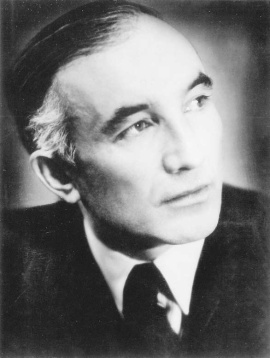
Hans-Martin Theopold (Doigtés)
Prof. Hans-Martin Theopold, was born to a pastor’s family in Detmold on 22 April 1904, the youngest of five children. Even as a child he often played the organ in the “Marktkirche” and soon began to take piano lessons with Theodor Vehmeier. At the age of 17 he made his debut at the Landestheater in Detmold with Ludwig van Beethoven’s Piano Concerto in C major under Friedrich Quast (Herford). Following the successful completion of his schooling at the Gymnasium Leopoldinum in Detmold, he went on to study music and piano (main subject): from 1922–23 at the “Württembergische Hochschule für Musik” in Stuttgart (with Max Pauer, 1866–1945) and then from 1923–1928 at the “Staatliche Akademische Hochschule für Musik” in Berlin-Charlottenburg (with Richard Rössler, 1880–1962, and Waldemar Lütschg, 1877–1948). After completing his piano studies (graduating with “very good”) in 1928, he began an active solo career both at home and abroad (USA, Switzerland, Scandinavia, the Baltic states, the Balkans). As a member of the Chamber Music Association of the State Opera in Berlin (from 1933) he also gave countless chamber music concerts, including ones with his violin partner Gustav Havemann (1882–1960).
In the 1930s, audiences and the press alike raved about Theopold’s extraordinary gifts as a pianist: “This young player has it in him to soon become one of the best players in Germany. A superior technique, a wonderful singing piano tone, the strength of a Titan, but not at all hard due to the incomparably gentle elasticity of his touch” [Münchener Zeitung, 21 November 1933]. – “H.M. Theopold gave convincing proof of his splendid pianistic ability in an extremely gripping sonata with a modern idiom by Alban Berg, but predominantly in Schubert’s […] Wanderer Fantasy, which he played with a polished technique and creative power” [Weser-Zeitung, 21 December 1932]. Theopold was awarded several prizes, including the “Grotrian-Steinweg-Preis” in 1928.
In 1937 Theopold became a teacher for the piano (main subject) at the “Bayerisches Staatskonservatorium der Musik” in Würzburg. In 1939 he married Irene Tatjana Wülfing, who was from Moscow. From 1943 he became head of the piano master-class at the “Nordische Musikschule” in Bremen, although this was interrupted by the events of the war. Following his return from a prisoner of war camp, Theopold gave concerts and taught although he did not hold a permanent position. From 1955–1956 he was acting head of the piano master-class at the “Bergisches Landeskonservatorium” in Wuppertal, finally being appointed Professor for Piano on 1 April 1956 at the “Staatliches Institut für Schul- und Volksmusik” in Detmold, later at the “Nordwestdeutsche Musikakademie Detmold” (today “Hochschule für Musik Detmold”), where he taught for decades. On 30 September 1969 he retired. “His students extol his pedagogical gifts. […] Humour, charm, helpfulness and kind-heartedness moderate the strictness of his professional ethos as a musician and teacher” (Lippische Rundschau, 23 April 1969; see also: Lippische Landeszeitung 22 April 1969 on the occasion of Theopold’s 65. birthday: “Prof. Theopold, a modest but at the same time energetic man, is an enthusiastic teacher”). Theopold died in Detmold in 2000.
Contact with Günter Henle was established directly after the publishing house was founded, when Theopold thanked the publishers with great enthusiasm for its first Urtext editions. His extensive correspondence with the publishing house was bequeathed to the Lippische Landesbibliothek in 2014 to ensure its long-term accessibility to the public. The letters testify not only to Theopold’s great interest in musical sources and text questions but also to his initial strict refusal (!) of fingerings in text-critical editions such as these: “For fingerings are and remain something individual no matter what their quality” (letter to Günter Henle from 26 May 1949 {publishing house archives}). Günter Henle was not, however, to be swayed and stressed the necessity of fingerings in his Urtext editions: “It is better to publish the Urtext […] with fingerings that are not necessary for a few individuals, or that might even, I admit, be considered irritating here and there” (letter to Hans-Martin Theopold of 17 September 1953).
It was only in 1955 that Theopold accepted Günter Henle’s offer of contributing fingerings for an Urtext edition that was in the process of being prepared by way of trial. (HN 74, Schubert, Complete Dances for Piano, Volume 1). Following this, Theopold was commissioned to write the fingerings for nearly all of the publishing house’s new editions in quick succession. Günter Henle, himself a good pianist, greatly valued Theopold’s fingerings, and also the many suggestions regarding the musical text in question. In addition, Theopold was always very reliable, thorough and conscientious – something that is not unimportant with editorial work!
Thus to date Hans-Martin Theopold has provided the fingerings for the greatest number of Henle Urtext editions by far – 226 editions (!) in total.
We would like to thank Mrs Margot Theopold and the Hochschule für Musik in Detmold for their great support in providing biographical material.
G. Henle Verlag
Informations sur la sécurité du produit

G. Henle Verlag
Vous trouverez ici des informations sur le fabricant du produit.G. Henle Verlag e.K.
Forstenrieder Allee 122
81476 München
Allemagne
info@henle.de
www.henle.com
Zu den erfreulichen Beiträgen im Jubiläumsjahr gehören diese vier Veröffentlichungen des Henle-Verlages. Dazu zählen die vergleichsweise preiswerten Studienpartituren, die von großem Wert für Studenten, Profimusiker und interessierten Laien sind …
Toccata, 2007These newly-printed versions were submitted for review in pocket score format and I am sure they will be of inestimable use to both students and other concert-going enthusiasts.
Music Teacher Australien, 2007The same edition of the trios also appears (at somewhat reduced size) in Henle’s excellent boxed set of Mozart’s complete chamber music with piano which also includes volumes of the piano and violin music, the piano quartets, the sublime quintet for piano and winds K 452, and the curious and rarely performed Adagio and Rondo or Harmonica Quintet K 617, for the once-fashionable glass harmonica (or piano), flute, oboe and cello. Once again, these are sturdy, beautifully produced and authoritative study scores at a reasonable price – highly recommended.
Music Teacher, 2006Como en el caso de la obra para piano, la caja ofrece una posibilidad de harcerse con toda esta música de una vez y en ediciones con la calidad habitual de Henle.
Doce Notas, 2006Zum Mozartjahr erscheint im Münchner Henle-Verlag eine weitere hochwertige Veröffentlichung, die in keiner Bibliothek fehlen sollte.
Ensemble, 2006recommandations
autogenerated_cross_selling
Autres éditions de ce titre
Autres éditions de ce titre


